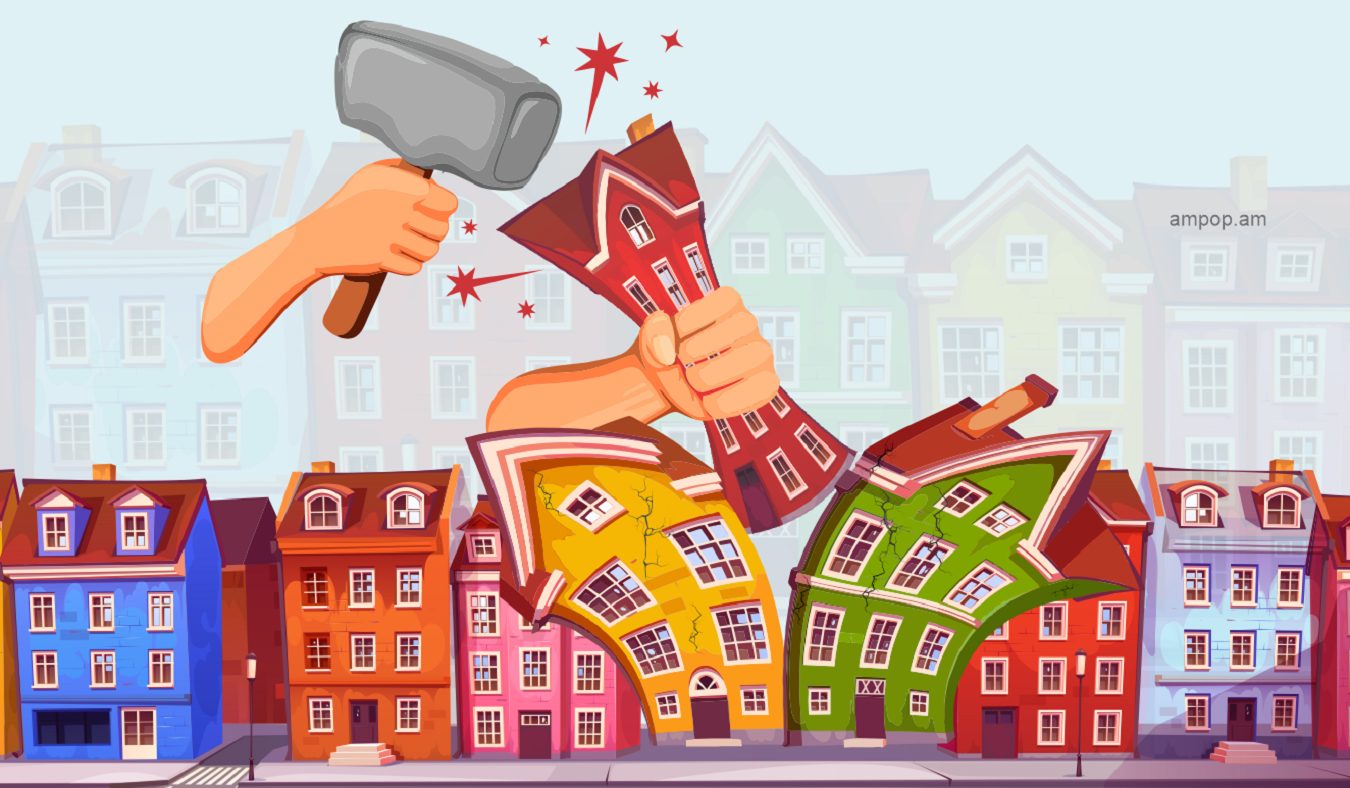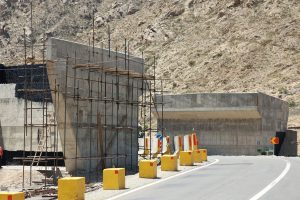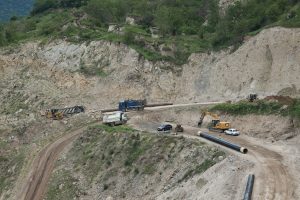Editor’s note: The numerous construction sites throughout Yerevan are causing inconveniences for its residents. Excessive construction dust has become a daily part of life in the city, exceeding allowable levels. As construction progresses, it involves the installation of infrastructure such as gas lines, sewage systems, and electrical power lines. Unfortunately, these often disrupt streets and sidewalks, which are frequently left unrepaired once the infrastructure is in place. Sometimes, these makeshift repairs result in potholes that contribute to frequent road accidents in the city.
However, these are relatively minor and hopefully temporary issues caused by the extensive construction in Yerevan. Concerns related to the ongoing construction in Yerevan become more significant when it comes to matters of safety.
Ampop Media features a three-part story by Karine Darbinyan entitled “National security concerns due to skyscrapers towering in Yerevan”. The story will explore the construction of housing blocks and its potential consequences on people’s safety, including demographics, seismic activity, food, and environmental safety, among other aspects. The first story delves into recent shifts in the real estate market and their impact on the demographics.
The Situation
The Income Tax Refund Law that has been in effect starting 2015 has had a major role in boosting the construction of residential buildings across Yerevan. The law allowed for paying off mortgage using the sum of the income tax retained from a person’s salary in the case the latter purchases an apartment directly from a construction company.
The legislative initiative was set on the agenda back in mid-2010 with the purpose to revitalize the economy of the country by means of boosting the construction sector. Though the law covers the whole territory of the country, in practice it proved to be more applicable in Yerevan, since majority of residential construction activities happened to be predominantly in the capital.
The supply was there, and so, it took short to shape the demand for an apartment in the capital, with the prices for apartments keeping growing before the two crises struck the country in 2020. The COVID-19 pandemic and the Second Artsakh War that followed hit the real estate market having a restraining effect on the prices. Yet, this did not last long.
As the Second Artsakh War unfolded, as well as the regular insurgencies of the Azerbaijani army into the territory of Armenia in 2021 and 2022, caused people from Artsakh, Syunik, Gegharkunik, and Vayots Dzor move in the direction of the capital and the adjacent regions. Migration became even more intense with the arrival of Russian nationals following their country’s intrusion into Ukraine in the February of 2022, and the mobilization announced in Russia in September of the same year.
Thousands of Russians opposing the Kremlin policies and unwilling to be conscribed to the country’s army were fast in deciding to opt for Armenia for an uncertain period. The number of Russians entering the country starting 2022 has grown by 32% against the number in the pre-pandemic 2019, with the positive migration balance growing fivefold.
Of the 1 130 000 Russian nationals who arrived in Armenia in 2022, 65 000 appear to have settled in the country. For comparison, the total population in the towns of Kapan and Goris in Syunik regions is 61 000.
Heated up by the demographic trends, the rental and purchase prices for apartments in Yerevan started to grow. The data for the years 2019 through 2021 showed comparable ups and downs in the real estate prices; starting March 2022 though the number of apartment seekers increased to the extent that it caused a gap between the supply and the demand on the market, and the prices for rental kept growing exponentially over months.
Starting February of this year, though, the prices seem to tend for decrease. The prices in May 2023, for instance, have been lower as compared to those in June 2022 (see the image below).
As to the apartments listed for sale, the influx of Russians, invigorated the market affecting the number of closed deals. The market also triggered construction in Yerevan. And while the prices for rental show tendency to decline, the prices on apartments are growing; in average, the increase in prices for apartments has exceeded 20% in January of the current year, as compared to the same month in 2022.
In an attempt to trigger construction of apartment blocks beyond the confines of Yerevan, in November 2021 the National Assembly of Armenia approved amendment to law, according to which the income tax refund option is expected to become unavailable in the capital by 1 January 2025.
The impact of the decision is visualized in the graphs showing the total areas of newly built residential blocks in Yerevan and the regions for the last five years. In 2018, about 77% of the construction of residential blocks was concentrated in Yerevan; following the amendment of the law, a significant part of it has moved to the neighboring regions of Ararat and Kotayq.
In other words, the solution was to go beyond the capital, while staying close to it.
With the set dates for changes in the availability of the refund option coming close, the construction companies use it as an argument (others include seismic safety measures, applied insulation systems, etc.) to attract buyers (the images of commercials and advertisement by contractor companies are shown below).
The shifts in demographics
The dispersion of population in Armenia has changed to a major degree. Yerevan, the capital of the country, as well as the nearby regions, are densely populated, whereas the rural settlements get depopulated.
Demographer Artak Markosyan believes, to keep people in their native settlements, particularly, the borderland communities, the state needs to first and foremost make a huge effort to improve the situation with the security. As a next step, the expert points to the creation of substantial social guarantees for people.
As of 2022, more than a third of Armenia’s population (about 37%) is registered in the capital. The population of Yerevan has grown by 3% (that makes 32 000 people) in the span of 10 years. As opposed to Yerevan, the number of people in the regions has been declining by 5% in average. The highest rates of decline in population have been registered in Lori, Vayots Dzor, and Shirak regions.
“There is nothing new about migration; it can be traced back to the 1970s. However, it must be said, in those times the reason behind it was social-economic, but today the matters of safety have added up to it a lot. People are mostly concerned with the deteriorated situation with the security,” the expert says.
A survey in 2021 showed the main concern of the populations in Syunik and Tavush is the shattered security following the war in 2020, which has a direct and a major impact on the social situation.
The decline in the population in the regions is typical to both rural and urban communities, according to the data of the Statistical Committee of Armenia. The only exception is the town of Abovyan, which has shown growth in population. There are also small towns where the population has remained unchanged.
The concentration of residential buildings in Yerevan alone deepens the development gap already existent between the capital and the regions.
This may end up in a situation, when the regions, particularly those neighboring Azerbaijan, get depopulated, whereas the capital gets even more densely populated and uncomfortable for life, which in its turn may bring about a number of life-threatening issues ranging all the way from seismic safety, to environmental, demographic, as well as border problems.
“High-rise buildings stand extremely close to each other, creating a sort of a chaos, and the state bodies seem to be unable to control the situation. Construction resembles a steam engine; it provides cash to the budget, and so principles and willpower get neglected,” architect Albert Zurabyan, the founder of the “Zaart” architectural studio, says.
Read Part II. National security concerns due to skyscrapers towering in Yerevan
By Karine Darbinyan
Illustration by Anush Baghdasaryan
Data analysis and charts by Karine Darbinyan and Garik Harutyunyan
Interviews by Lilit Poghosyan
This multimedia project has been created as part of the project titled “The Link Between Housing Construction in Yerevan and Forced Migration Caused by the NK and Ukrainian Wars” which is supported by the ForSet Data Communication Fellowship Program.
© All the stories, infographics and other visuals bearing the Ampop Media logo is possible to publish on other audiovisual platforms only in case of an agreement reached with Ampop Media and/or JFF.
Փորձագետի կարծիք
First Published: 27/07/2023















